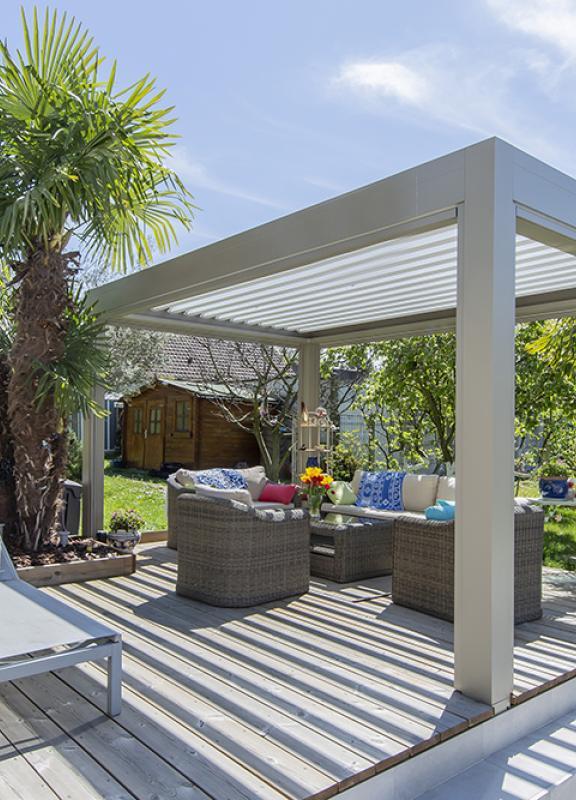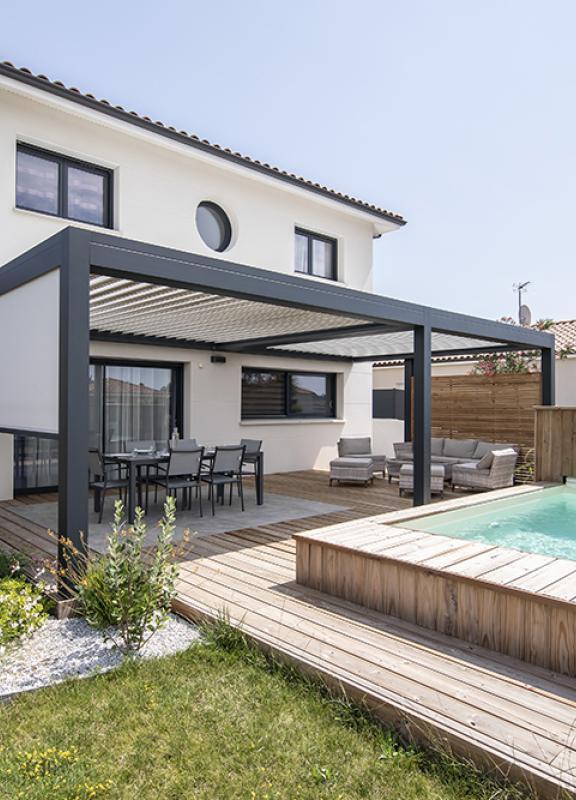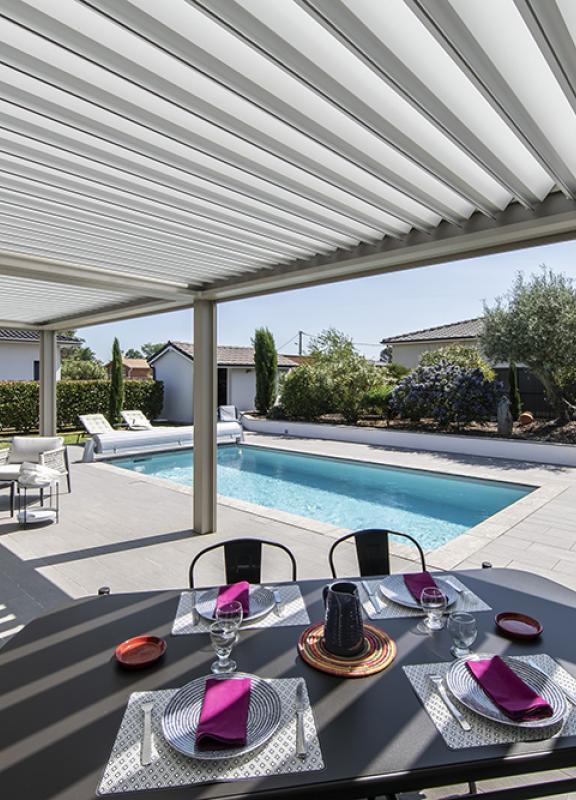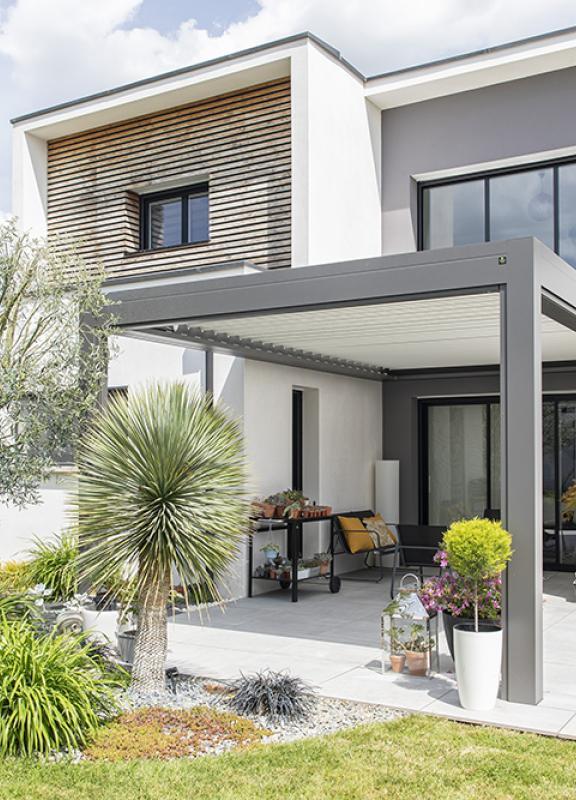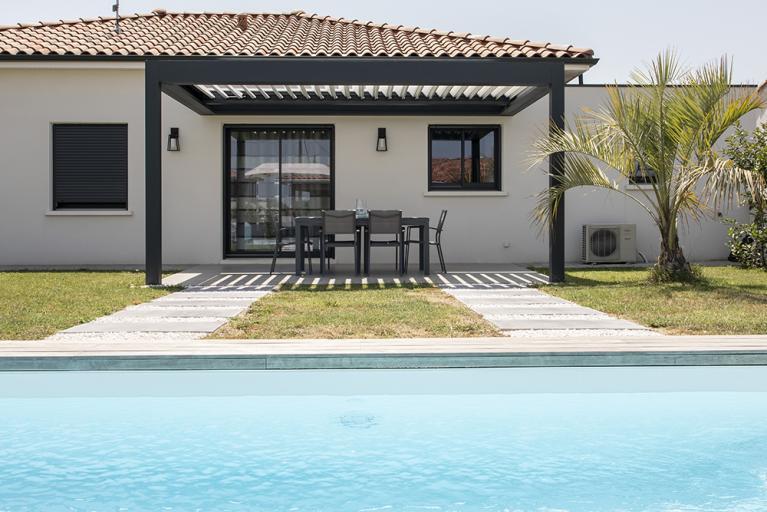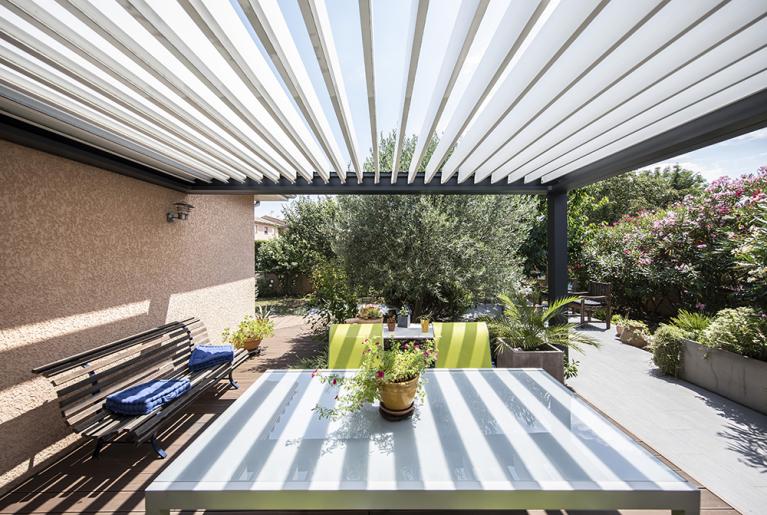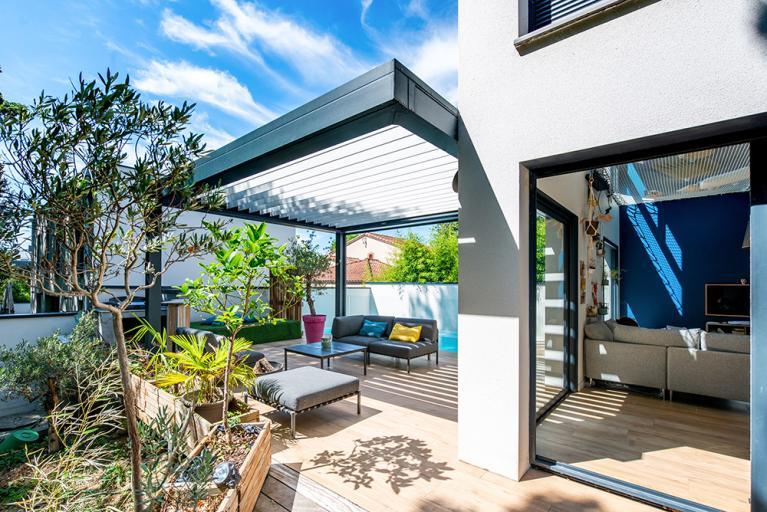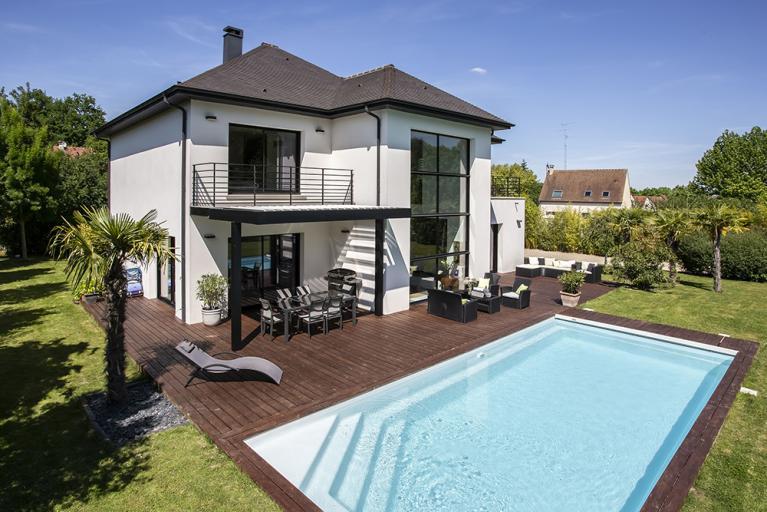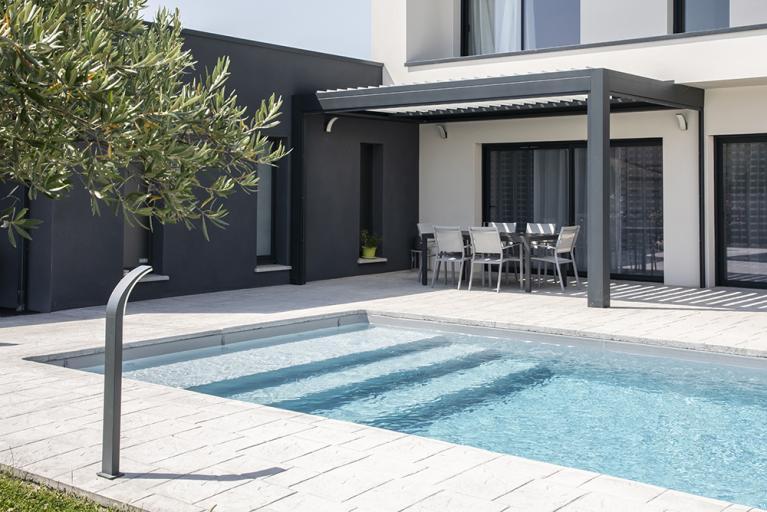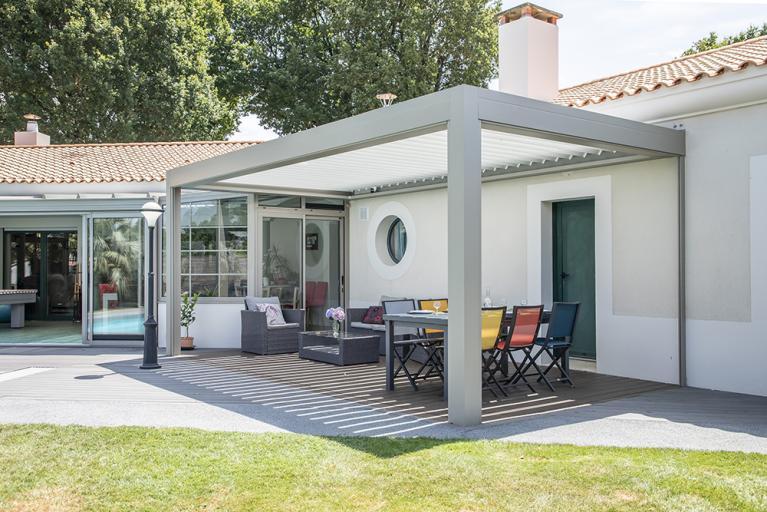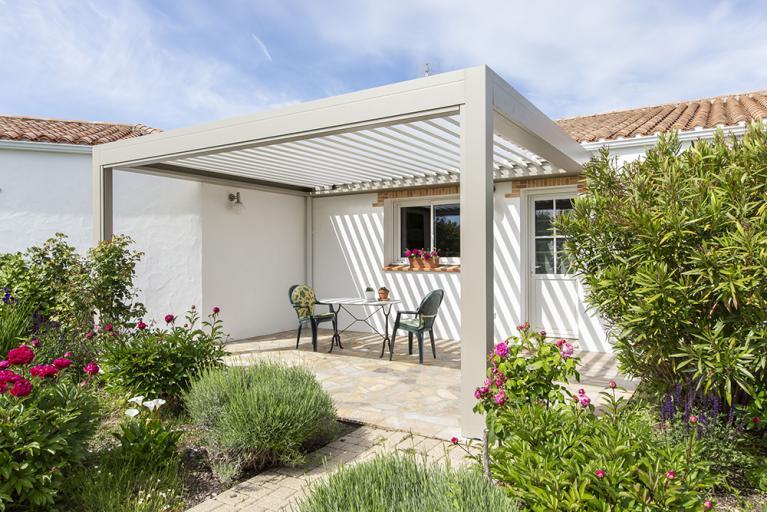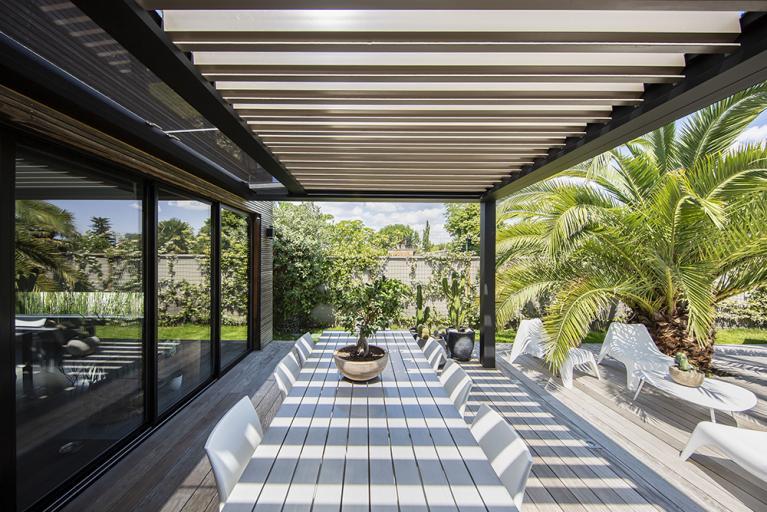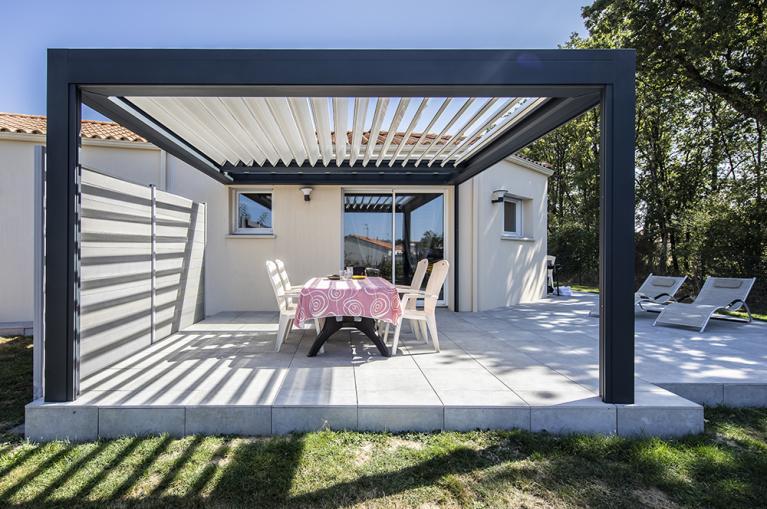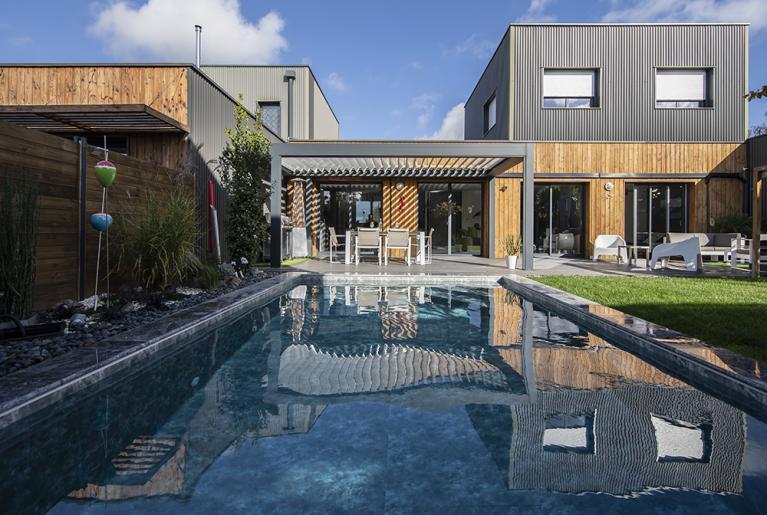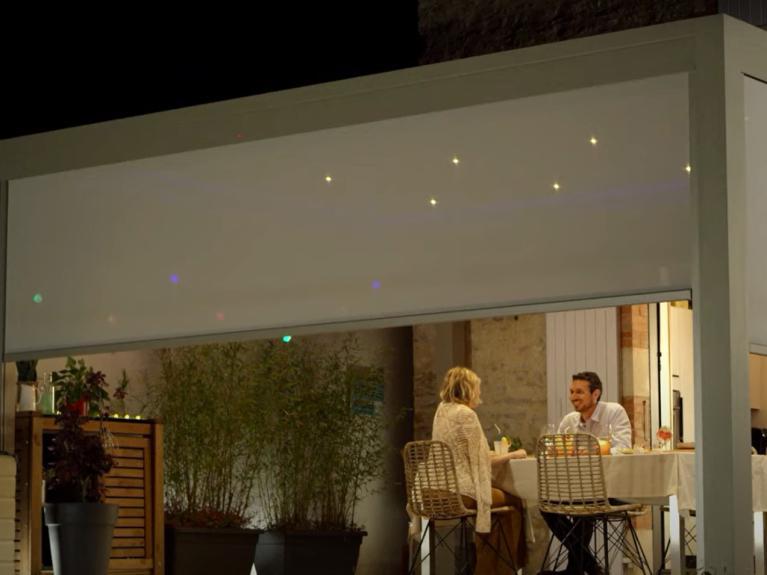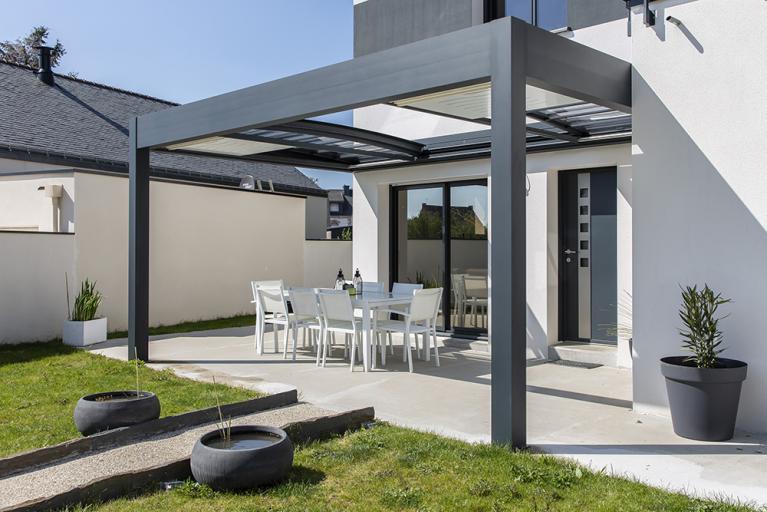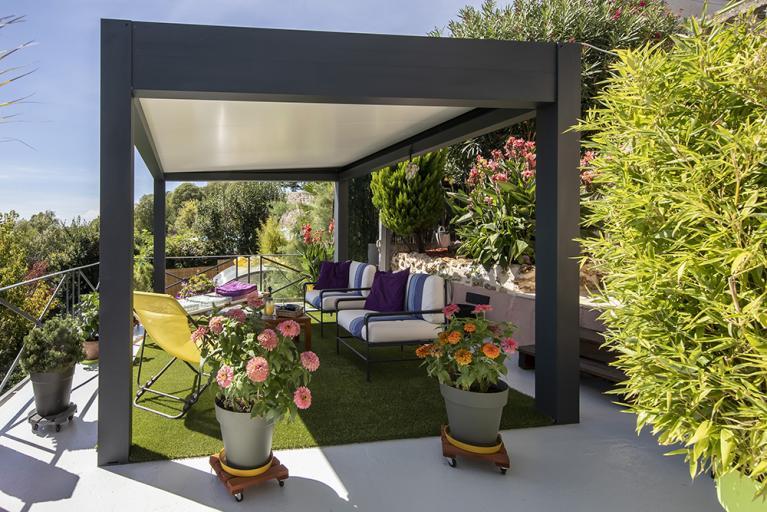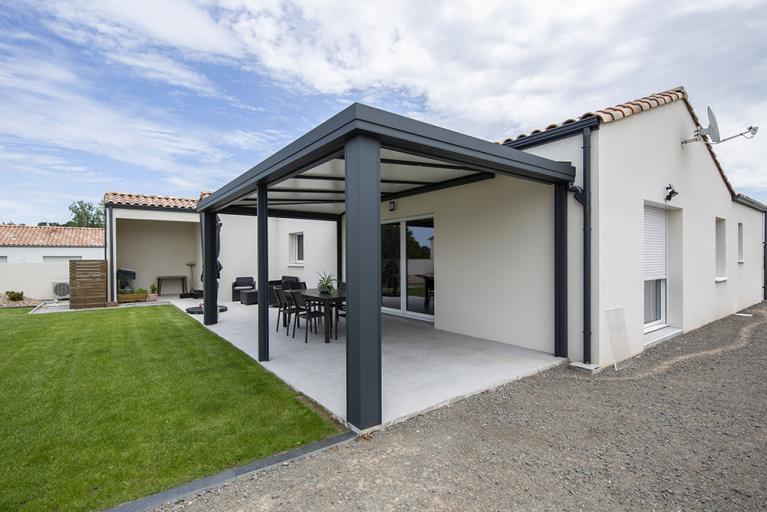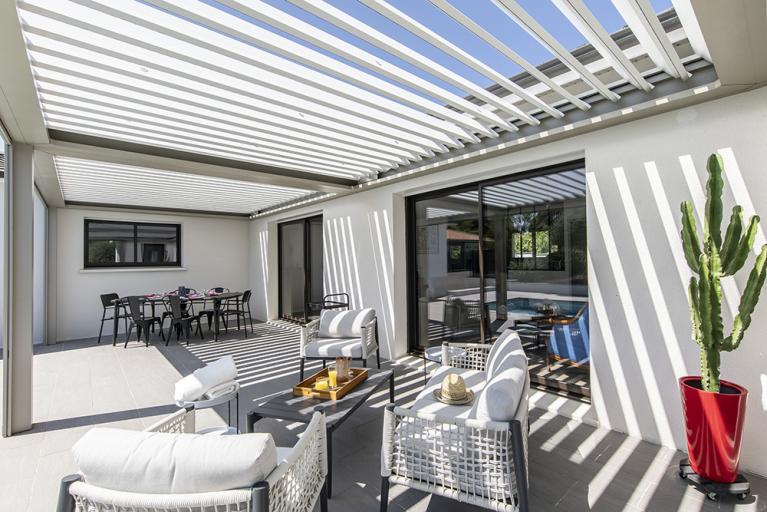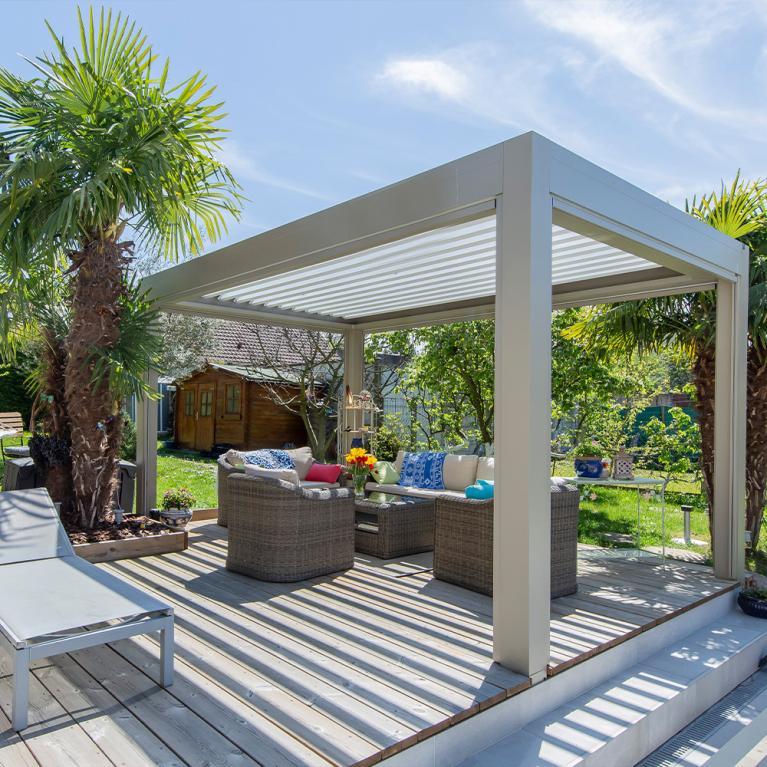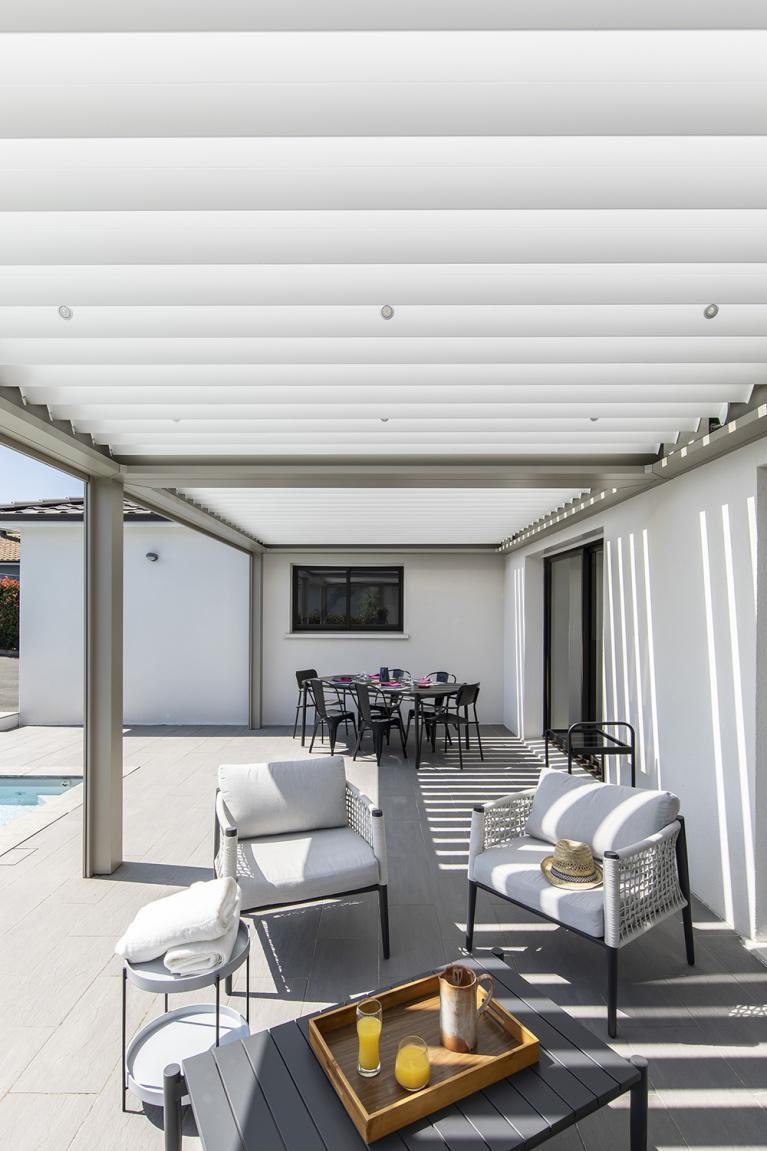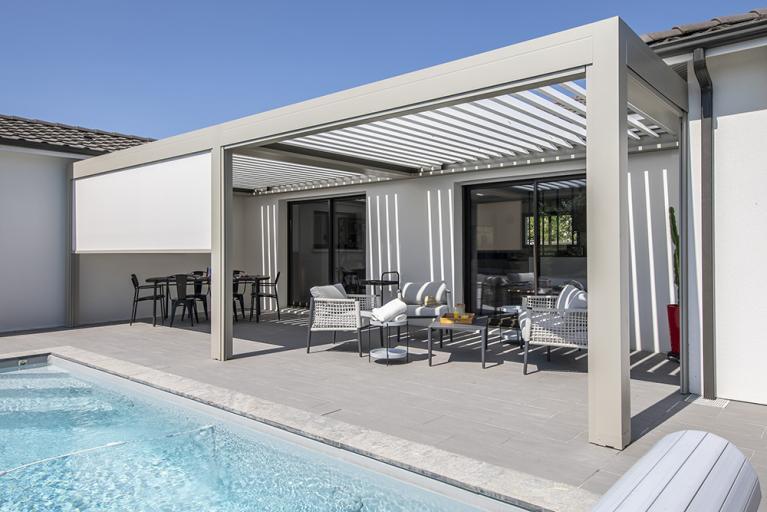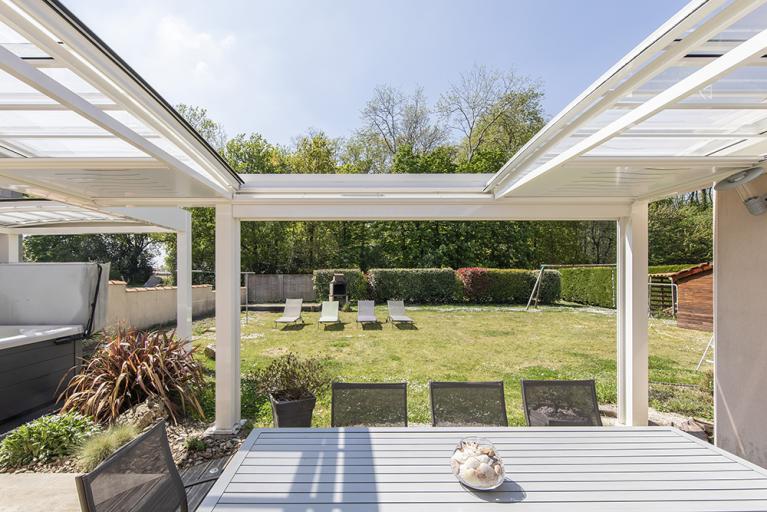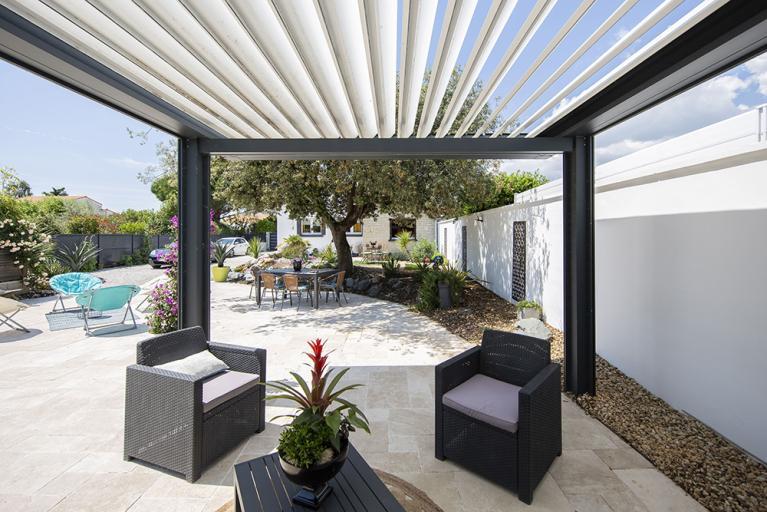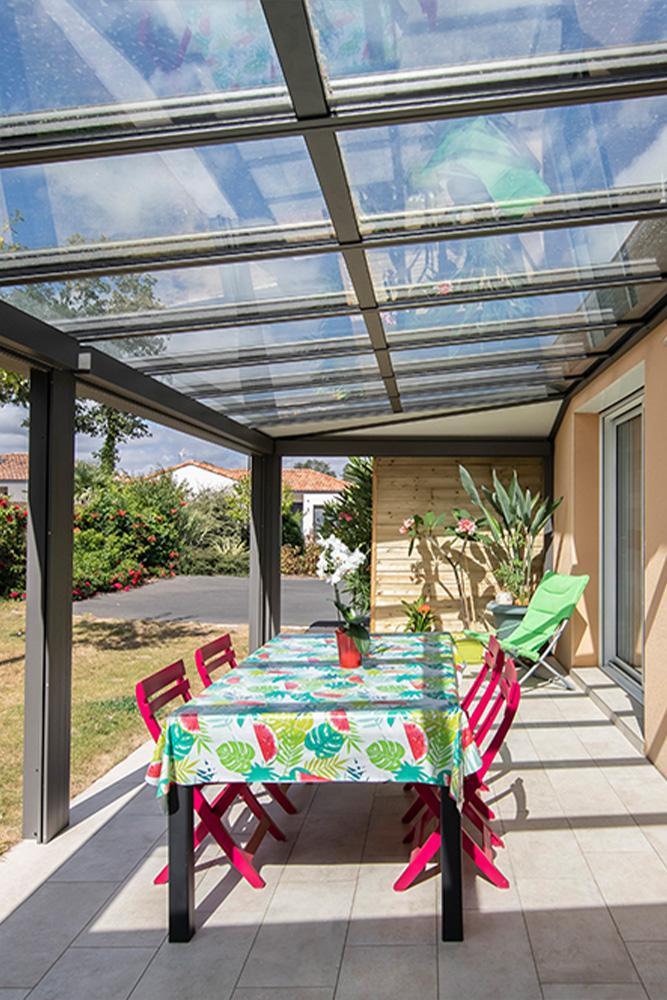Bioclimatic pergola: adjustable slats to adapt to all weather conditions
Leaning against the house or installed in the garden, the pergola offers ideal protection from the sun, wind and rain. And to enjoy the outdoors even more comfortably, in all weathers, a version with adjustable roof slats was developed a few years ago.
Modern, comfortable and efficient, the bioclimatic pergola has many advantages.
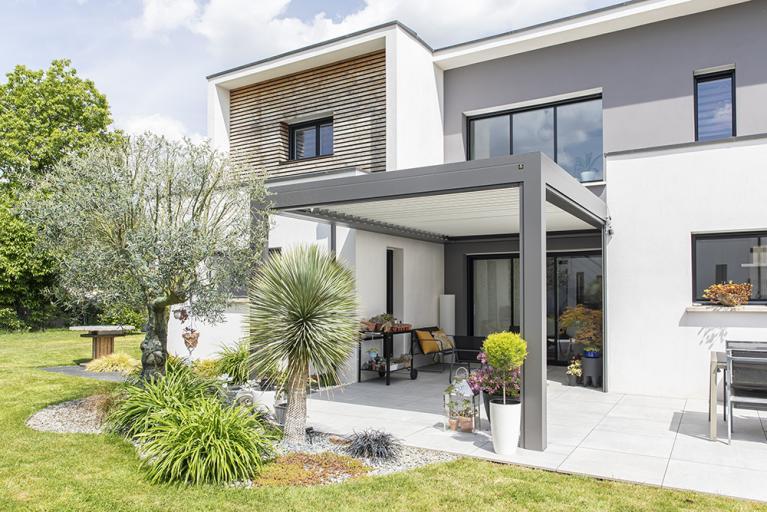
The positioning of the bioclimatic pergola
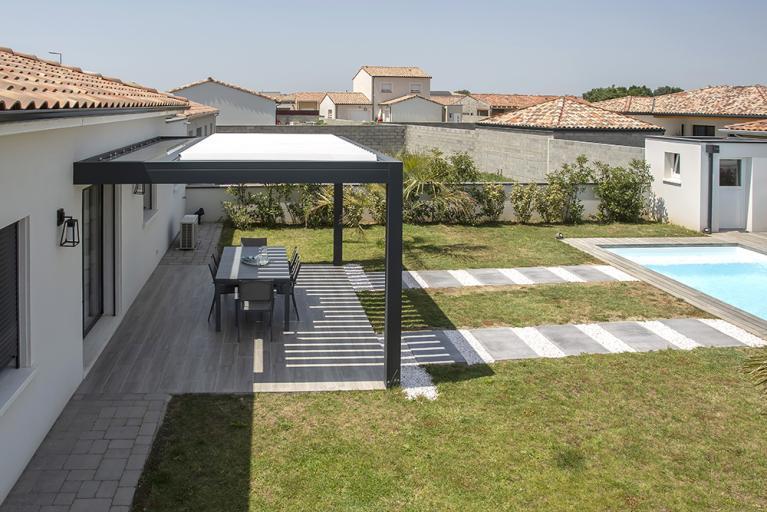
The lean-to bioclimatic pergola
This model is fixed to the wall of the house and rests on 2 or 3 posts, depending on the width of the pergola. For widths over 6m and depths over 4.5m, an additional post is required. The slats are positioned parallel or perpendicular to the façade.
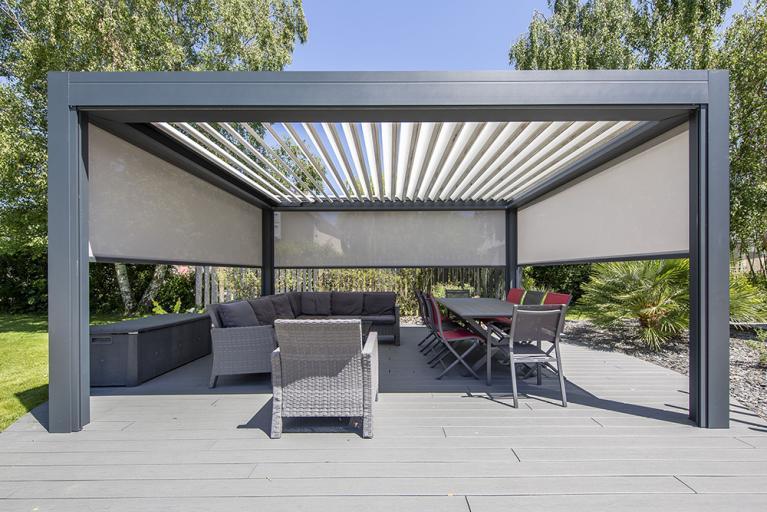
The free-standing bioclimatic pergola
This model is based on 4 or 6 posts depending on the dimensions of the pergola. Beyond 6m in width and 4.5m in depth, two additional posts are needed to maintain the structure. The slats are positioned in a parallel or perpendicular manner.
Colour & style
Colours, cornices, offset posts... below you will find the customisation options we offer.
Colour:
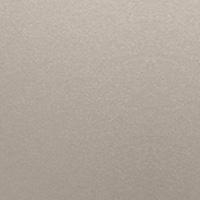
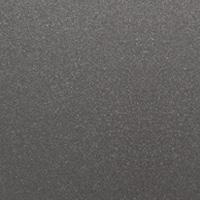




Personnalisation :
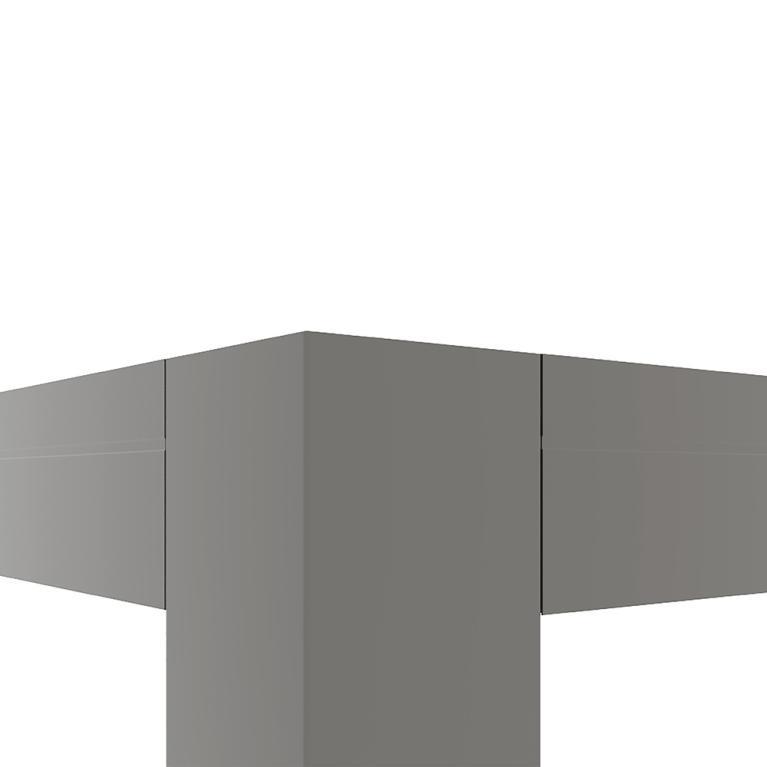
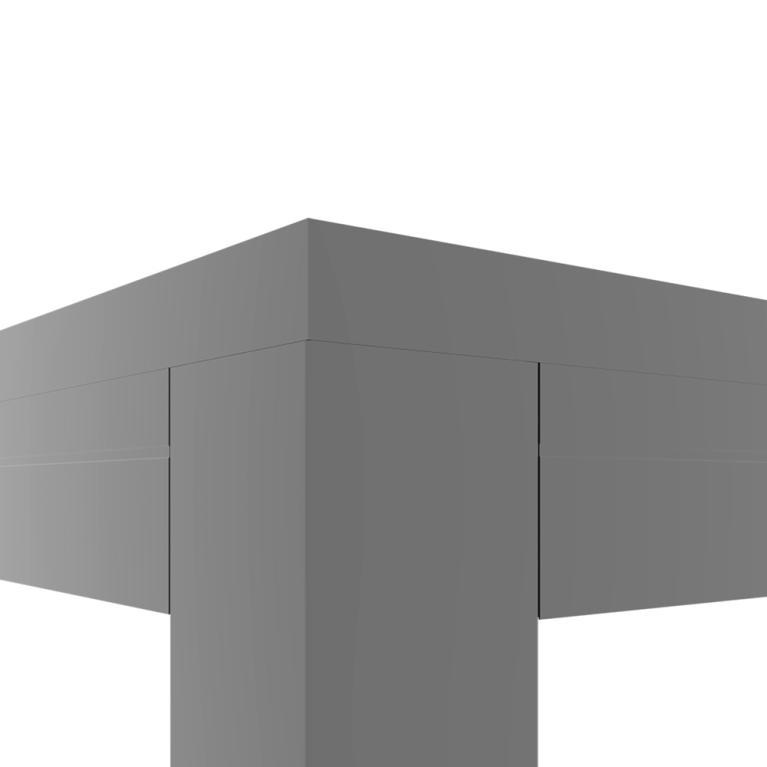
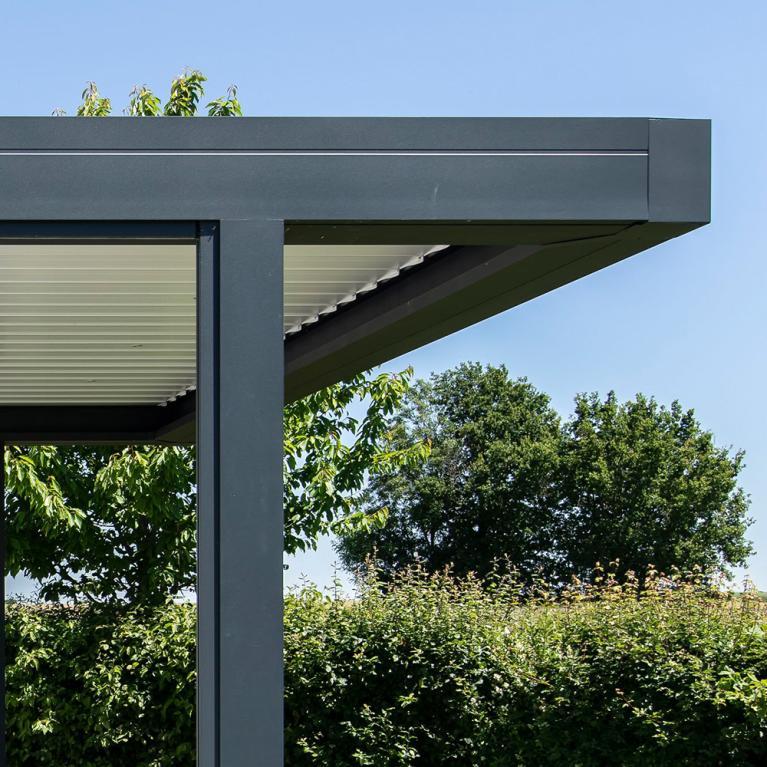
The lighting
- LED spotlights integrated into the slats or peripheral LED strips: the choice is yours to extend your evenings and add colour to your terrace.
- Low-consumption LED lighting with dimmer to adjust the brightness according to the desired ambience.
- Motorised lighting, easy to control using the pergola remote control.
- LED strips available in white or RGB (8 colours).
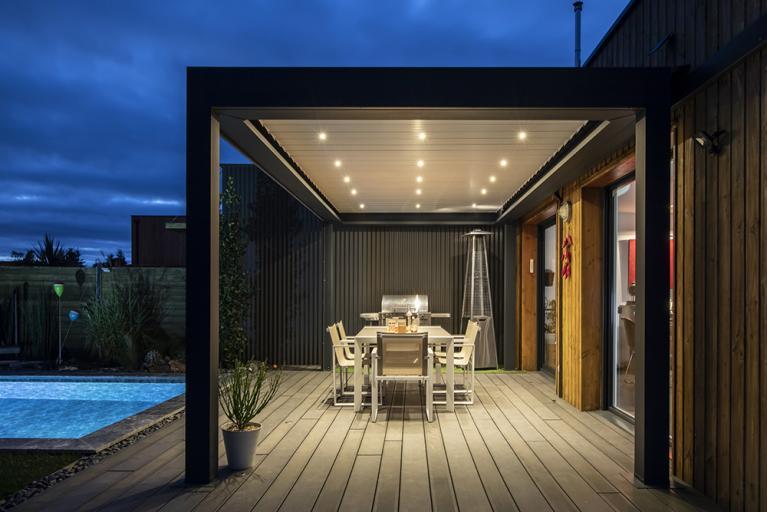
The equipment
Facade protection, Protect option... our design office has studied several options to make your pergola more comfortable.
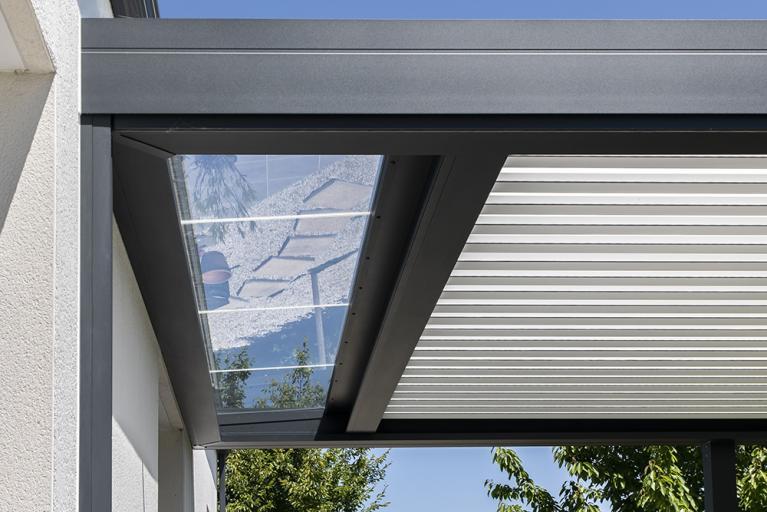
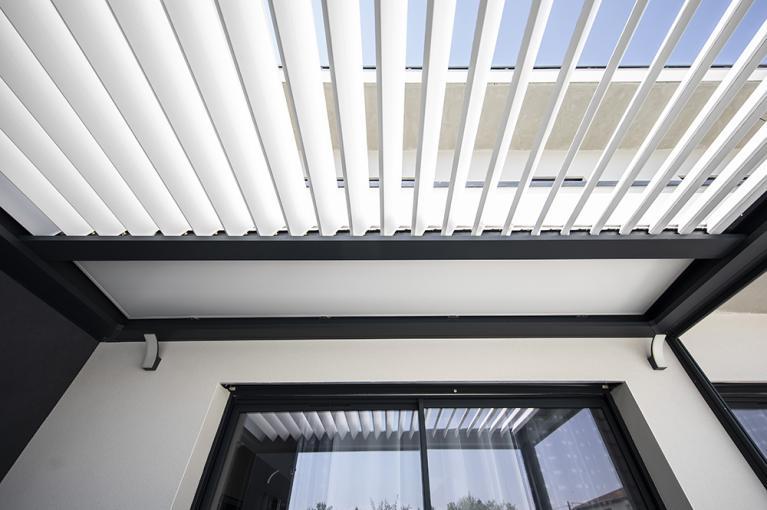
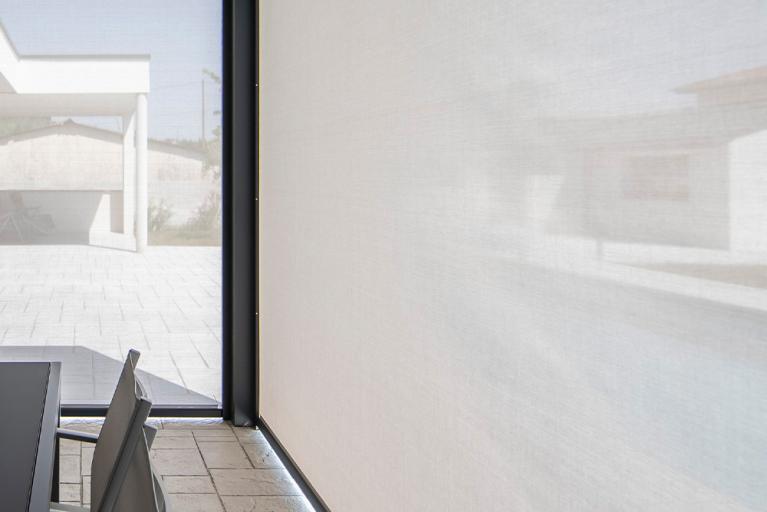
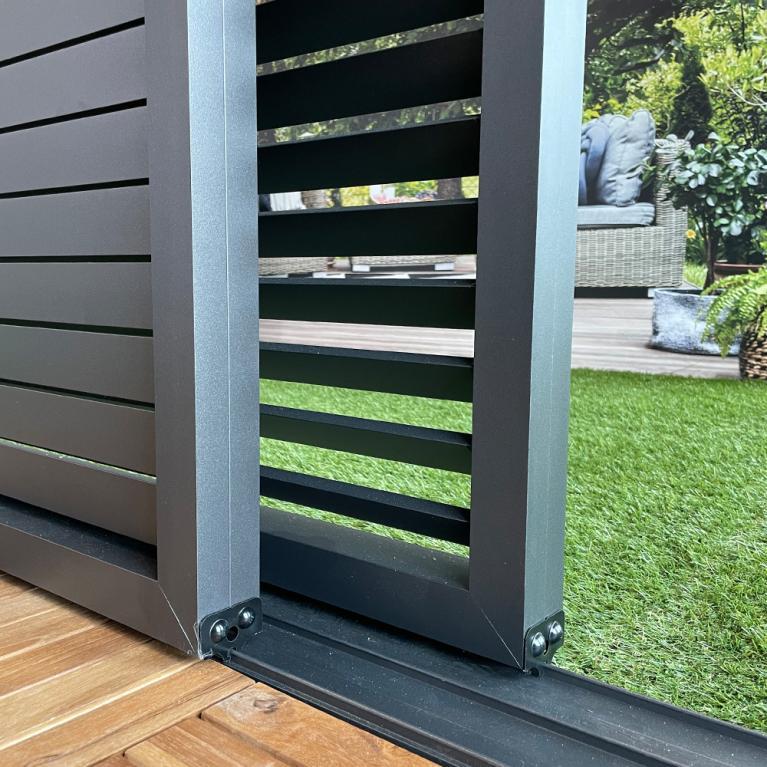
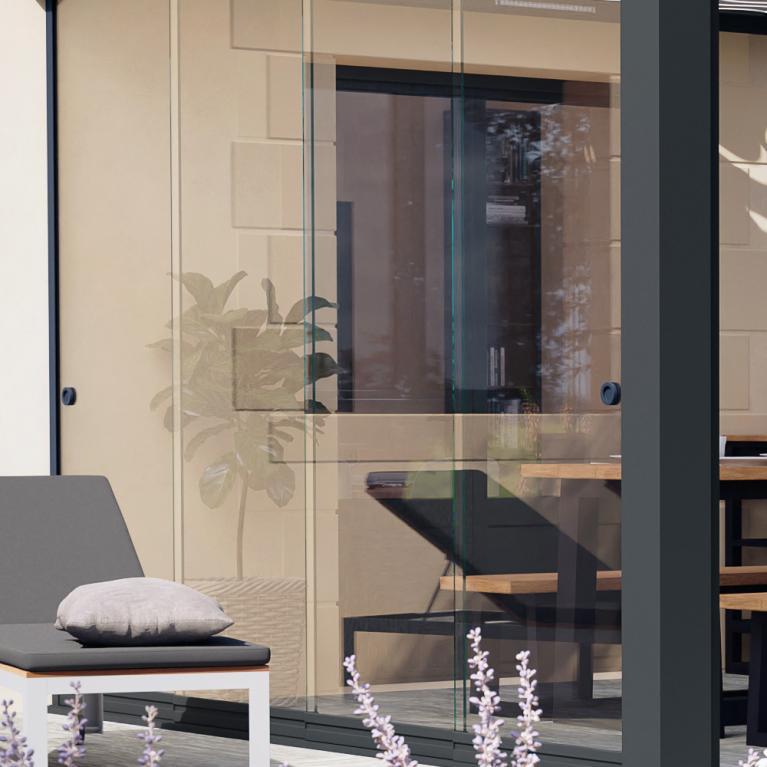
How does Akena help you and assess your budget?
The cost of your project depends on numerous parameters, particularly the dimensions and the equipment that you would like to add to your project.
Discover the achievements of bioclimatic pergolas
So what is the difference between a pergola and a bioclimatic pergola? What are the advantages of a bioclimatic aluminium pergola? And how do you choose a pergola with adjustable slats that is suited to your needs?
A pergola with adjustable slats
Ideal for protecting yourself from the elements, the bioclimatic pergola offers even more comfort than a conventional model. Its adjustable slats allow it to adapt quickly and easily to all weather conditions.
-
What is a bioclimatic pergola?
-
A bioclimatic pergola is an outdoor structure that provides a shaded area for relaxing and lounging while offering protection from the weather. This type of pergola is becoming increasingly popular due to its many advantages, including its ability to regulate temperature and sunlight naturally.
Bioclimatic pergolas are designed to be more than just a shelter. They are equipped with adjustable slats that can be set to provide partial or complete shade. The slats can also be tilted to allow air circulation, which is ideal on hot and sunny days.
The bioclimatic pergola can also be equipped with vertical blinds or sliding glass or sliding privacy screens that provide additional protection from the wind and rain. This means that you can enjoy your terrace or garden all year round, whatever the weather.
One of the main advantages of a bioclimatic pergola is its ability to regulate the temperature. The adjustable slats can be used to block direct sunlight on hot days, reducing the temperature by several degrees. On cooler days, the slats can be tilted to allow sunlight to warm the space.
Bioclimatic pergolas are also aesthetically pleasing. They can be designed to harmonise with your house and garden, thus offering a natural extension of your living space. In addition, the adjustable slats can be adjusted to create unique lighting effects, adding a touch of sophistication and style to your garden.
In conclusion, the bioclimatic pergola is an ideal solution for those looking to create a shaded and comfortable area in their garden or on their terrace. By regulating the temperature and sunlight in a natural way, it offers an ecological and economical alternative. Moreover, with its elegant and aesthetic design, it can improve the appearance of your outdoor space while offering a pleasant place to relax.
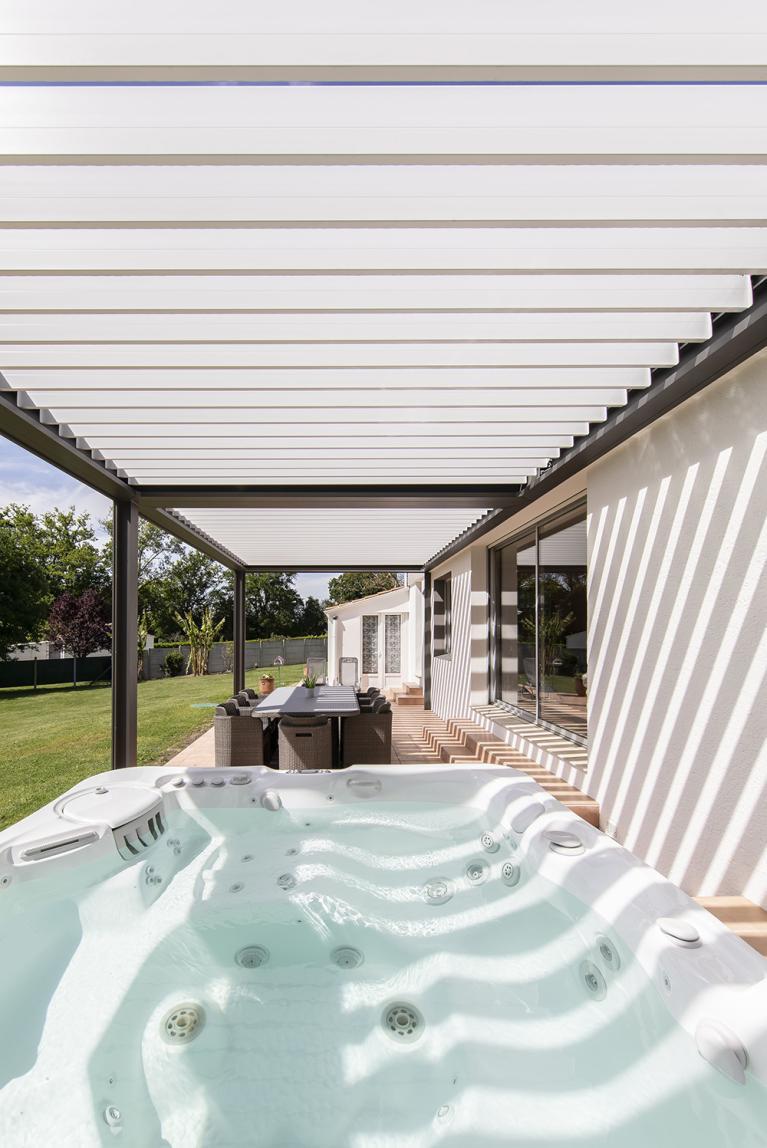
Ideal for protection from the elements, the bioclimatic pergola offers even more comfort than a conventional model. Its adjustable slats allow it to adapt quickly and easily to all weather conditions.
A covered outdoor space for the terrace or garden
A real asset for the home, the pergola is a covered outdoor space that provides effective protection from the sun's rays and bad weather. Unlike a veranda, it has a roof but remains open at the sides (although it can be partially or totally closed without being completely waterproof). Perfect for enjoying the outdoors from spring to autumn, this open shelter allows for ideal circulation between the house and the garden.
Installed on a terrace, against the facade of the house, the pergola extends the living room or kitchen: when the warm weather arrives, it offers a new, convivial and warm living space. Solid and resistant, it is also more watertight, more durable and often more attractive than a simple awning. It can also be installed in the middle of the garden to create a pleasant place for lazing around and relaxing, or near a swimming pool for lounging in the shade.
Originally designed with a fixed roof, the traditional pergola has undergone many changes in recent years. Equipped with a roof with adjustable slats, the customised bioclimatic pergola is now the most versatile and efficient model.
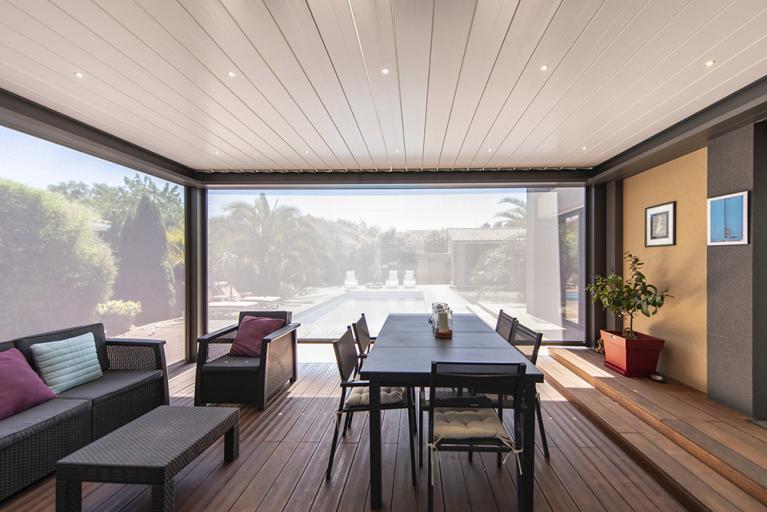
A roof with adjustable slats
More than just a simple shelter, the bioclimatic pergola is equipped with a roof with adjustable slats. These slats optimise the pergola's management of sunlight and ventilation, adapting to changing weather conditions.
When the slats are closed, this pergola model offers the same advantages as a conventional model: a waterproof roof between the slats, which protects from the sun's rays and the rain. But when the fine weather arrives, its adjustable slats can be opened: they then allow light to enter and the first rays of the sun to be enjoyed. This intelligent system generally offers an inclination of 0 to 135°, for optimal management of the opening and the light. In addition to aerating and ventilating the space, it allows you to enjoy a pleasant breeze. The slats can then be easily adjusted to provide shade and coolness.
Like a fixed pergola, the pergola with adjustable slats can be attached to the front of the house (with two or three fixed legs depending on the width), or installed as a freestanding unit (self-supporting or self-supported, on four or six legs depending on the dimensions). Parallel or perpendicular, the slats are generally made of aluminium. While they can be operated manually, using a crank, most models are motorised: controlled by remote control or by a switch, they offer a more responsive system. The most efficient bioclimatic pergolas are also equipped with intelligent sensors, which automatically close the slats in case of rain.
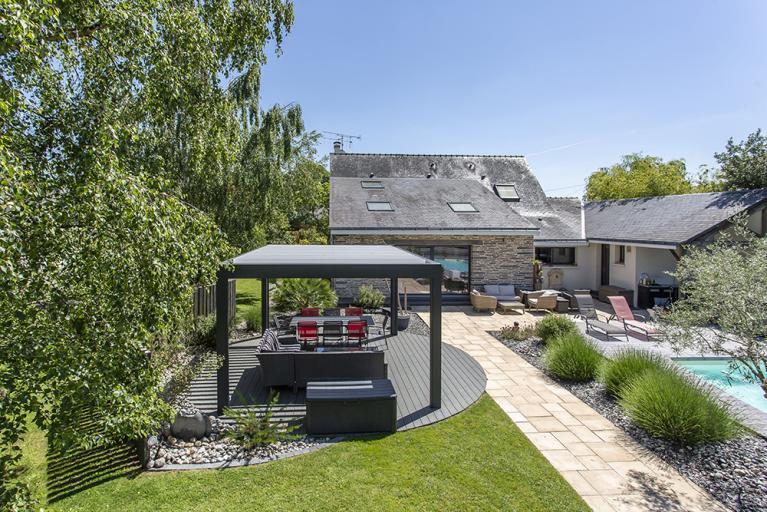
-
What are the advantages of a bioclimatic pergola?
-
Comfortable, practical and attractive, modern, high-performance and durable... Taking advantage of the latest innovations and technologies in the sector, the bioclimatic pergola offers many advantages.
A comfortable outdoor shelter that adapts to the weather
As mentioned above, the pergola is the ideal solution for protection from the sun and bad weather, while enjoying an open space and an unobstructed view of the garden. It makes it easier to be outside in rainy weather, to relax, to share a moment with the family or lunch with friends, etc. Comfortable and convivial, this outdoor space is perfect for enjoying the warmer temperatures as spring arrives. Easier and quicker to install, a bioclimatic pergola is also less expensive than a conservatory.
This type of pergola also has the advantage of not darkening the room in front of which it is installed: simply open the roof slats to enjoy maximum light. And if the slats are correctly angled, they allow you to maintain good light while offering protection from the sun's rays.
Installing a bioclimatic pergola allows you to enjoy a very practical and easy-to-use outdoor shelter. Its motorised rotating slats can be adjusted to the nearest degree, to enjoy optimal light and better ventilation throughout the day. Thanks to a remote control, the roof blades can be closed quickly and easily in case of rain or wind (some models can even be controlled via smartphone). And the models with rain or wind sensors are even more convenient to use. No need to rush for the remote control at the first drop of rain: the pergola roof closes automatically!
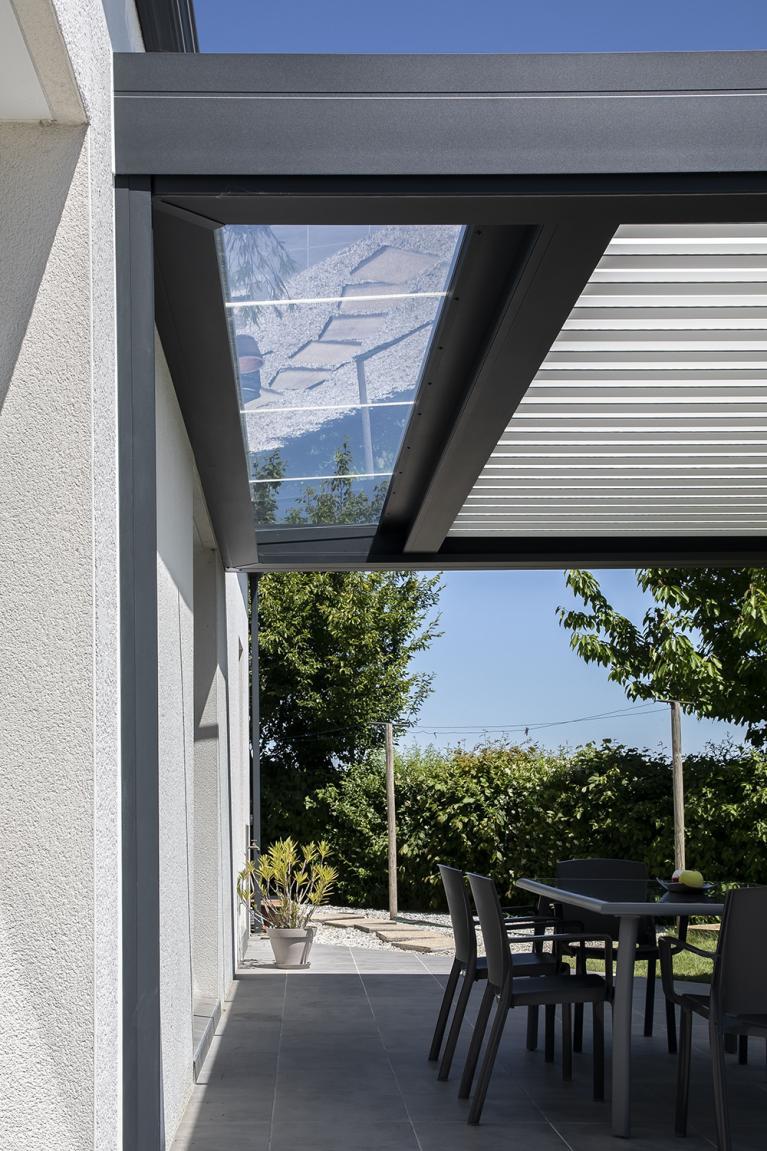
Controlled sunlight and energy savings for the home
When placed against one of the house's façades, the bioclimatic pergola can be a real asset in managing energy consumption. It facilitates the regulation of the interior temperature and air circulation in a natural way.
In summer, the sun's UV rays are particularly powerful: instead of penetrating directly into the house (through windows, doors and bay windows), they can be stopped by the roof of the pergola. All you have to do is close the retractable slats during the hottest hours of the day (between about 12 noon and 4 p.m.). The pergola then offers real protection from the sun, allowing you to enjoy a pleasant feeling of coolness inside the house (even more so if the pergola is installed on the south side). It is no longer necessary to activate the air conditioning system, which can lead to significant savings on your energy bill.
In winter, the sun's rays are not as effective and the air cools down. But if they penetrate inside the house, they can easily warm up the ambient air. In addition to providing more light inside, opening the slats of your pergola during the winter can therefore also help to improve thermal comfort. UV rays are not blocked by a fixed roof: they enter the room more easily to heat it naturally, allowing the heating temperature to be lowered. In addition to saving on energy bills, this outdoor equipment also helps to limit its impact on the environment. Reducing energy consumption by taking advantage of natural resources: the bioclimatic pergola lives up to its name!
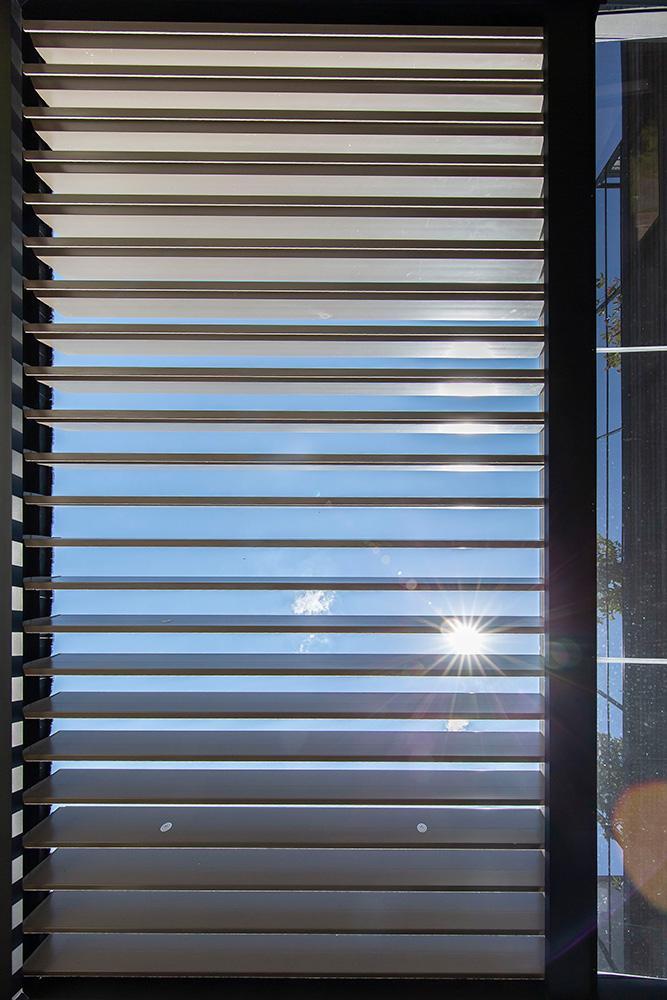
-
How to choose the ideal model for your home?
-
There are now several models and ranges of bioclimatic pergolas. So what are the essential criteria to take into account when purchasing one, to be sure of making the best choice?
A custom-made pergola, perfectly suited to its use
Enlarging your living room to the outside, installing a summer kitchen by the pool, creating a relaxation area in the middle of the garden or creating a remote terrace... The use of the pergola is one of the first criteria to consider. It allows you to define its size and its future location.
First you need to decide whether the pergola will be installed against a wall of the house (on a terrace, for example), or in an open space. This will enable you to choose the right model of pergola: a lean-to pergola (with two legs) or a freestanding pergola (with four legs). Its future location also depends on the size of the garden, the orientation and the amount of sunlight the house receives, the view and the immediate surroundings, etc.
To choose the size of the bioclimatic pergola, you then need to take into account the space available on the front of the house or in the garden. Although there are several models of bioclimatic pergolas available in kit form (and in several sizes), it is nevertheless advisable to opt for a made-to-measure bioclimatic pergola. In addition to adapting perfectly to the surface to be fitted out, this type of pergola integrates more easily into the house or garden. It can be fully customised to meet certain specific needs.
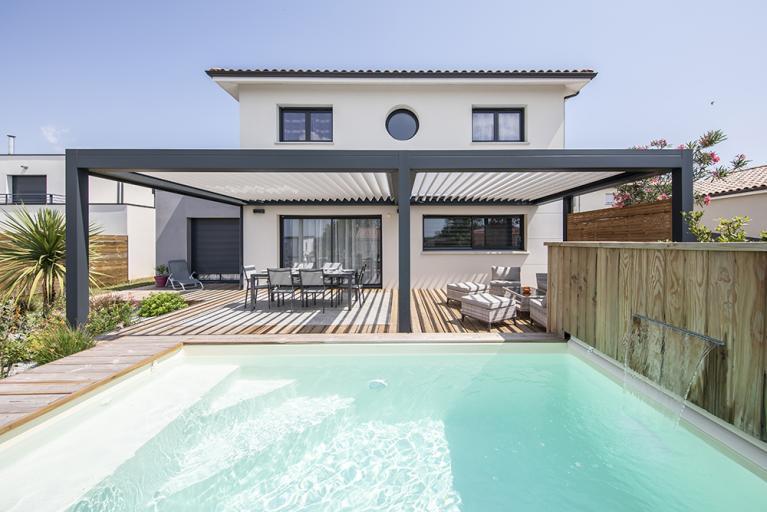
A pergola with adjustable aluminium slats, for solid and durable equipment
Several materials can be used to make the structure of the bioclimatic pergola (posts and crossbeams).
- PVC: light and resistant, it does not require any special maintenance. However, it can fade under the effect of UV rays, and may not be durable enough over time;
- wood: timeless and elegant, this material brings a warm and natural touch to the pergola. However, it must be treated regularly to maintain its appearance and resist the external elements (rain, wind, sun, insects, fungi, etc.);
- wrought iron: elegant and durable, this material is more expensive than the others. It also requires regular and meticulous maintenance (against rust, in particular);
- aluminium: light, ultra-resistant and durable, it is the ideal material for a bioclimatic pergola. The structure can be lacquered in any colour, to blend in perfectly with the house or garden. Aluminium requires very little maintenance (a simple cleaning with soap and water), and is highly resistant to bad weather and UV rays.
At Akena, we have opted for aluminium. It is the material used for 95% of conservatories, pergolas and carports in France.
The motorised slats of the pergola roof are generally made of aluminium. To be sure of choosing quality equipment, it is also recommended to check their thickness and the performance of their rotation system.
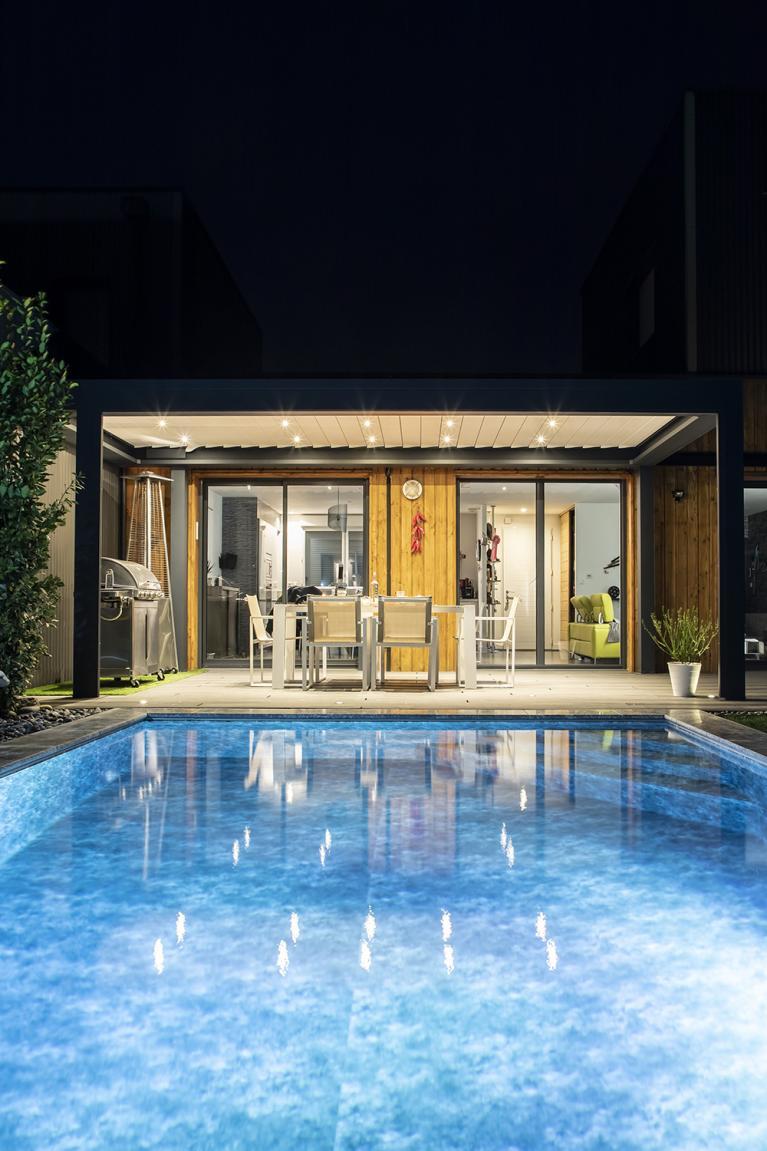
A customised bioclimatic pergola can also be equipped with several options and accessories
- rain or wind sensors, for a self-contained pergola that automatically adapts to the weather;
- a glass skylight, to enjoy maximum light even when the pergola slats are closed;
- LED lighting, with spotlights integrated into the blades or peripheral strips.
- side closures, for even more protection and privacy inside the pergola:
- sliding leaves, equipped with pivoting blades;
- sliding and panoramic glass panels;
- motorised side blinds.
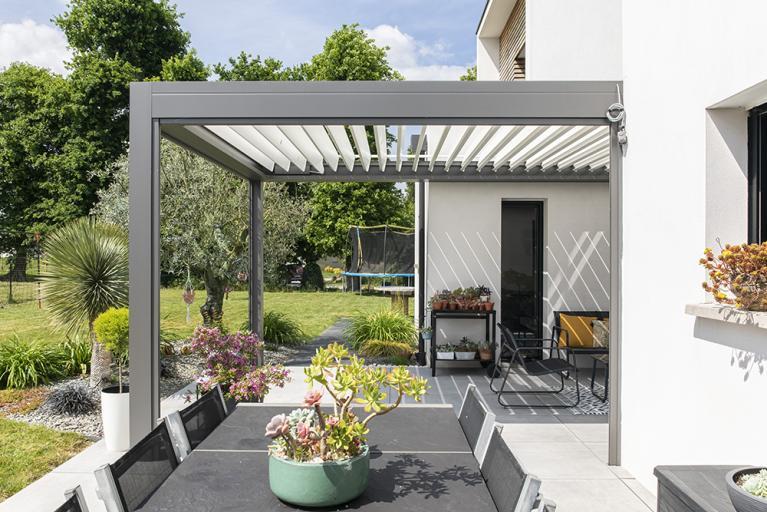
-
How much does a bioclimatic pergola cost?
-
The cost of a bioclimatic pergola depends on several factors such as size, materials used, level of customisation, features and additional options. In general, the price of a bioclimatic pergola can vary from a few thousand euros to tens of thousands of euros.
The basic cost of a bioclimatic pergola can vary between €10,000 and €12,000 for a medium-sized structure. However, this can increase depending on the options and additional equipment such as the addition of side blinds, integrated LED lights, side protection systems, motorised blinds, etc.
It is also important to note that the cost of installation may vary depending on the company chosen and the labour costs in your area.
In summary, the cost of a bioclimatic pergola will depend on various factors, and it is recommended that you contact professionals to obtain an accurate quotation based on your specific needs.

-
Which material should I choose for a bioclimatic pergola?
-
The choice of material for a bioclimatic pergola depends on your personal preferences, your budget and the location of the pergola. Here are some of the most commonly used materials for bioclimatic pergolas:
- Aluminium: aluminium is a lightweight, durable material that requires very little maintenance. It can be painted in a variety of colours to match your home and garden. Aluminium is also weather and rust resistant, making it a popular choice for regions where rain and humidity are common.
- Wood: wood is a natural material that gives a bioclimatic pergola a warm, rustic appearance. It is readily available and can be treated to resist the elements and insects. However, wood requires regular maintenance to retain its appearance and durability.
It is important to note that each material has its advantages and disadvantages. Before choosing a material for your bioclimatic pergola, it is important to consider factors such as location, climate and budget. It is also important to choose a quality material to ensure the long-term durability of your bioclimatic pergola.
- Wrought iron: wrought iron is a material traditionally used for bioclimatic pergolas because of its elegant appearance and durability. However, it is more expensive than other materials and requires regular maintenance to prevent rust.
- PVC: PVC is a lightweight, weather-resistant synthetic material that requires virtually no maintenance. It can be manufactured in a variety of colours and styles to suit all tastes. However, PVC can fade and deteriorate over time due to UV rays, which can affect its appearance and durability.
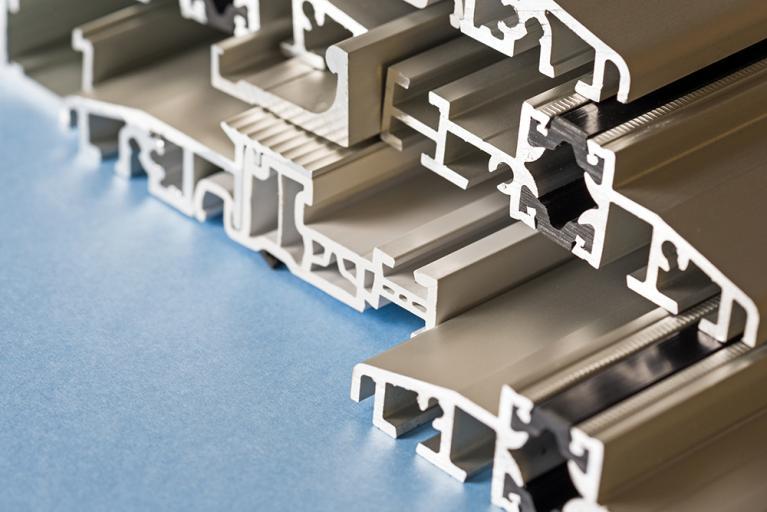
-
What is the best location for a bioclimatic pergola?
-
The ideal location for a bioclimatic pergola depends on many factors, including the size of your garden, the orientation of your house, local weather conditions and the intended use of the pergola. Here are a few things to consider when choosing the optimal location for your bioclimatic pergola:
- Orientation: Ideally, the pergola should be oriented to take advantage of the sun while providing comfortable shade during the hottest periods of the day. If your garden faces south, you can orient the pergola to the west or east to take advantage of the morning or evening sun while avoiding excess heat. Learn more about the ideal orientation for your pergola.
- Protection against the elements: The bioclimatic pergola is a very good alternative for protecting you and your terrace against the elements, particularly rain, wind and snow. Without being as watertight as your house or an insulated room such as a conservatory, the bioclimatic pergola will be an excellent solution in spring and summer to protect you and your outdoor furniture.
In summary, the choice of location for a bioclimatic pergola depends on your personal preferences and the intended use of the pergola. By keeping these different factors in mind, you will be able to choose the ideal location for your bioclimatic pergola in order to maximise its usefulness and your comfort.
- Privacy: If you want to use your bioclimatic pergola for relaxing with family or friends, you can choose a location that offers a certain degree of privacy. If you have close neighbours, you can consider adding side panels or climbing plants to create a more private area.
- View: If your garden offers a view of a beautiful landscape, you can position the pergola to enjoy this view while benefiting from shade and protection from the sun.
- Accessibility: The bioclimatic pergola should be easily accessible from your home so that you can enjoy it easily. You can also provide easy access for guests by installing a paved walkway leading to the pergola.
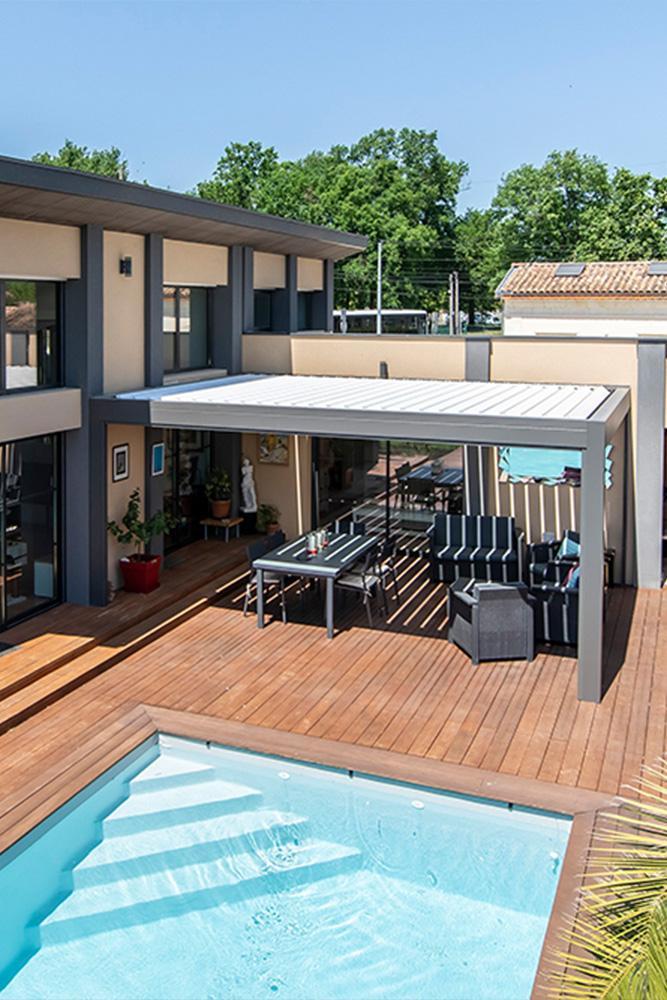
-
Why choose a pergola made by AKENA?
-
Akena offers different models of bioclimatic pergolas, certainly the widest range of accessories on the market. With adjustable slats, a fixed roof or sunroof, side blinds, fixed or sliding privacy screens with adjustable slats, the pergolas designed by Akena bring comfort and well-being to the terrace.
The price of a bioclimatic pergola at Akena depends on various criteria. Our models are custom-designed, and can be placed against or freestanding in your garden. Depending on the size of your pergola, you will be offered 1 or 2 modules.
And if you wish to add comfort equipment, the Akena technical advisors will be able to offer you the right solutions for your project. More information than the prices of our pergolas. We offer free detailed quotations with a 3D study of your project. So don't hesitate any longer, ask for your personal study!
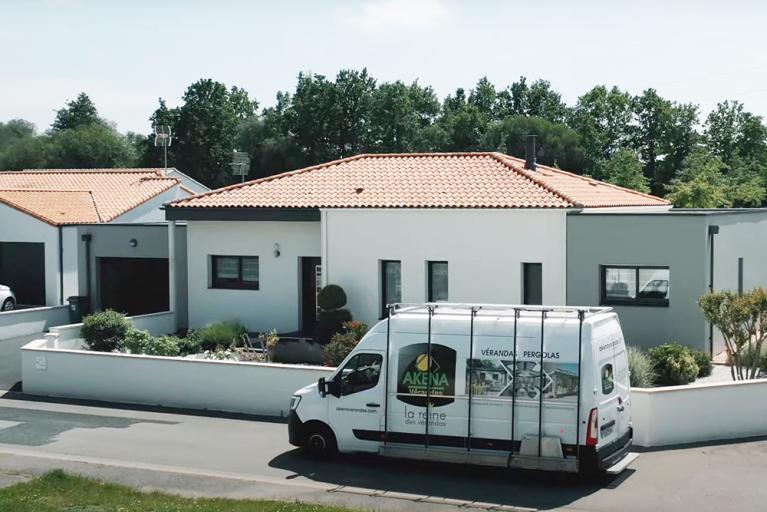
Our other products
Discover all the pergolas on offer below, they are endless, as extensive as Akena's expertise.
Commitment to quality
The magazine of the Akena company
You have a project?
Would you like a personalised 3D study and a free quotation? Contact us by clicking below.
AKENA is...
Over 40 years of experience
Founded in 1981 by one man, we now have more than 500 employees dedicated to making your project a success.
Made in France
A historic site and two factories covering more than 25,000 m² in Dompierre-sur-Yon in the Vendée region (85)
Innovative and tailor-made products
At AKENA, we are brimming with new ideas to improve and enhance our products.
The European leader in conservatories, pergolas...
But not only! AKENA also offers a complete range of carports and pool houses.
